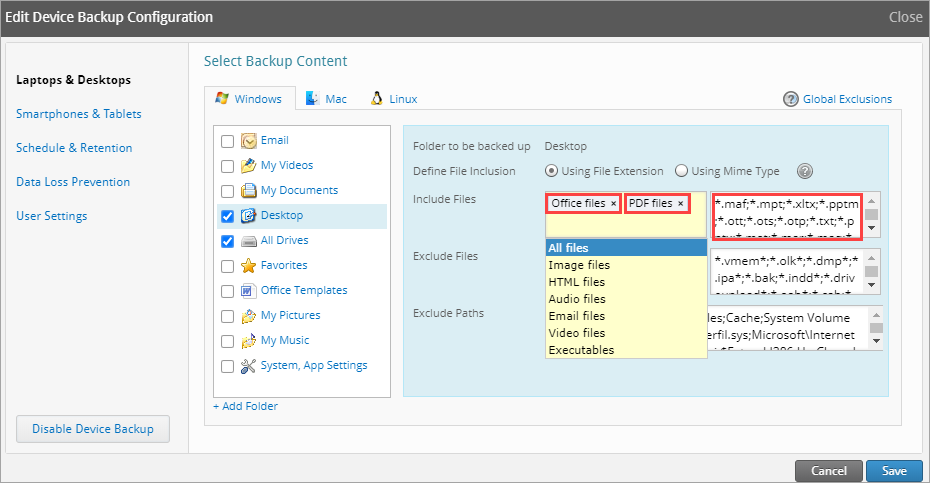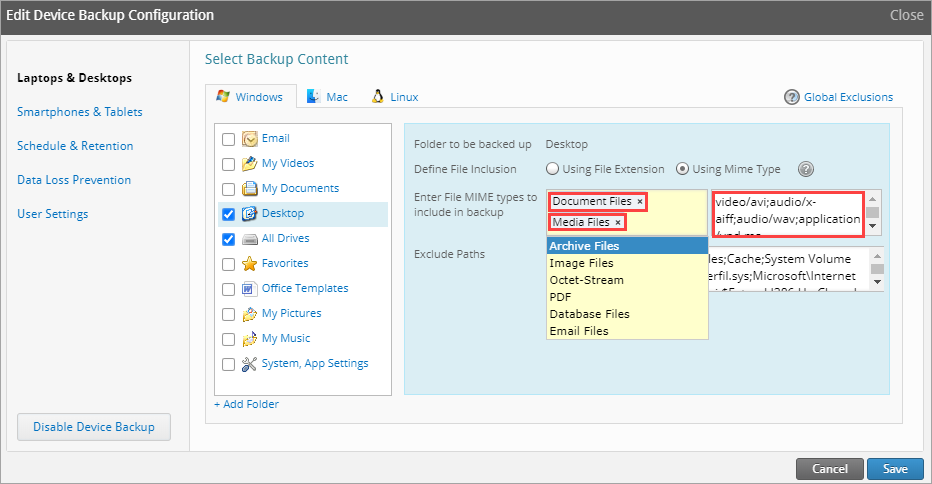Define file inclusions for backup
Overview
When it comes to protecting organizational critical data, you may want to ensure that business-critical data is not missed out from backups. And especially in legal hold and forensics cases, you may want to be double sure that any changes made to the file extensions by the users will not exclude business-critical files from being backed up. Which is why inSync provides you the option to define file inclusions for backup.
Defining file inclusions for backup is basically selecting the preferred method through which you want inSync to backup data on users' devices from the selected location.
inSync provides the following two options to define the file inclusions at profile level configuration for device backups:
- Using File Extension
- Using MIME Type
- Global exclusions are applicable only to file extensions and not applicable to file MIME types.
- This is a profile level setting and cannot be applied to the user level.
Backup data using file extensions
This method provides you the option to include and exclude the data from backup based on the file types and their extensions. When you select a particular file type from a range of available file types, inSync readily displays the list of file extensions for the selected file types.
Based on your organization's requirements and the data that you intend to back up from the user devices, you can select one or more file types and define the file extensions that you want to include or exclude from backup.
For the list of file types that are by default included for backup, see Defined file types for backup.
The following steps are involved to define file extensions for backup.
- On the inSync Management Console menu bar, click Profiles.
- Click the profile for which you want to define the file inclusions.
- Click the Devices tab > Laptops & Desktops.
- Click Edit. The Edit Device Backup Configuration window appears.
- As applicable, select the file types from the drop-down menu that you want to include for backup. The following example illustrates Office files and PDF files.

- Select the file extensions that you want to include in backups from the adjacent box.
Note: If you are looking for a specific file type and if it does not appear in the standard list, type the file extension in the adjacent box.
- As applicable, select the file types from the drop-down menu that you want to exclude from backup. The following example illustrates Executables.

- Click Save.
Backup data using MIME types
If the user accidentally or even intentionally changes the file extensions and if those file extensions are not defined in the backup rules, it may lead to data loss and the data would be unrecoverable in the event of a disaster.
Configuring inSync profiles to backup data based on file MIME types ensures that the organizational critical data is not missed from backup.
The following steps are involved to define file MIME types for backup.
- On the inSync Management Console menu bar, click Profiles.
- Click the profile for which you want to define the file inclusions.
- Click the Devices tab > Laptops & Desktops.
- Click Edit. The Edit Device Backup Configuration window appears.
- As applicable, select the file types from the drop-down menu that you want to include for backup. The following example illustrates Office files and PDF files

- Click Save.

